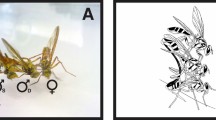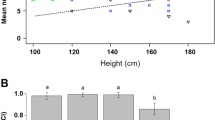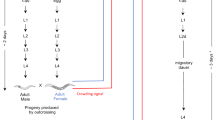Summary
Non-random mating may be involved in the maintenance of colour polymorphism in Adalia bipunctata. Mating choice experiments have been carried out on a stock of A. bipunctata from Keele. Specific frequencies of the melanic quadrimaculata form and the non-melanic typica form were placed in population cages or mating chambers and allowed to mate. The frequencies of the forms amongst mating pairs were scored. The results gave a good fit to a model of mixed sexual selection and assortative mating showing a strongly frequency dependent, non-assorting preference for quadrimaculata males in the matings. Data from the wild Keele population showed a similar preference for quadrimaculata males, and an excess of males of a second melanic phenotype, sexpustulata. Observation of courting pairs indicated that female choice determined frequency of mating. Field data from Keele also gave evidence of assortative mating between typica and another non-melanic form, annulata.
Similar content being viewed by others
Article PDF
References
Creed, E R. 1975. Melanism in the two-spot ladybird: the nature and intensity of selection. Proc R Soc Lond B, 190, 135–148.
Ellingsen, I J. 1969. Fecundity, Aphid consumption and survival of the aphid predator Adalia bipunctata L. (Col., Coccinellidae). Norsk ent Tiddsskr, 16, 91–95.
Hodek, I. 1973. Biology of Coccinellidae. Academia, Prague.
Karlin, S, and O'Donald, P. 1978. Some population genetic models combining sexual selection with assortative mating. Heredity, 41, 165–174.
Kimball, A W. 1954. Short-cut formulas for the exact partition of X2 in contingency tables. Biometrics, 10, 452–458.
Lus, J J. (Lusis) 1928. On inheritance of colour and pattern in ladybeetles Adalia bipunctata and Adalia decimpunctata. Izv Byuro Genet Leningrad 6, 89–163.
Lus, J J. (Lusis) 1932. An analysis of the dominance phenomenon in the inheritance of the elytra and pronotum colour in Adalia bipunctata. Trudy Lab Genet, 9, 135–162.
Lus, J J. (Lusis) 1947a. Some aspects of the population increase in Adalia bipunctata. 1. Heterozygosity of populations in lethal alleles. Dokl Akad Nauk SSSR, 57, 825–828.
Lus, J J. (Lusis) 1947b. Some aspects of the population increase in Adalia bipunctata. 2. The strains without males. Dokl Akad Nauk SSSR, 57, 951–954.
Lusis, J J. 1961. On the biological meaning of colour polymorphism of ladybeetle Adalia bipunctata L. Latv Ent, 4, 329.
Mader, L. 1926–1937. Evidenz der palaearktischen Coccinelliden und ihrer Aberationen inWort und Bild.Vienna.
Meissner, O. 1907a. Die relative Häufigkeit der Varietäten von Adalia bipunctata L. in Potsdam (1906). Z wiss Insekt Biol, 3, 12–20, 39–45.
Meissner, O. 1907b. Die relative Häufigkeit der Varietäten von Adalia bipunctata L. in Potsdam (1907). Z wiss Insekt Biol, 3, 309–313, 334–344, 369–374.
Meissner, O. 1909. Die relative Häufigkeit der Varietäten von Adalia bipunctata L. in Potsdam (1908). Z wiss Insekt Biol, 5, 231–242.
Muggleton, J. 1978. Selection against the melanic morphs of Adalia bipunctata (two-spot ladybird): a review and some new data. Heredity, 40, 269–280.
Muggleton, J. 1979. Non-random mating in wild populations of polymorphic Adalia bipunctata. Heredity, 42, 57–65.
O'Donald, P. 1978. Theoretical aspects of sexual selection: a generalized model of mating behaviour. Theor Pop Biol, 13, 226–243.
O'Donald, P, and Muggleton, J. 1979. Melanie polymorphism in ladybirds maintained by sexual selection. Heredity, 43, 143–148.
O'Donald, P. 1980. Genetic Models of Sexual Selection. Cambridge University Press.
Sem'Yanov, V P. 1970. Biological properties of Adalia bipunctata (Coleoptera: Coccinellidae) in conditions of Leningrad region. Zashch Rast Vredit Bolez, 127, 105–112.
Timofeeff-Ressovsky, N W. 1940. Zur Analyse des Polymorphismus bei Adalia bipunctata L. Biol Zbl, 60, 130–137.
Author information
Authors and Affiliations
Rights and permissions
About this article
Cite this article
Majerus, M., O'Donald, P. & Weir, J. Evidence for preferential mating in Adalia bipunctata. Heredity 49, 37–49 (1982). https://doi.org/10.1038/hdy.1982.63
Received:
Issue date:
DOI: https://doi.org/10.1038/hdy.1982.63
This article is cited by
-
The scent of love: how important are semiochemicals in the sexual behavior of lady beetles?
Journal of Pest Science (2016)
-
Phenotype-dependent mate choice in Propylea dissecta and its fitness consequences
Journal of Ethology (2014)
-
Effect of chromosome arrangements on mate recognition system leading to behavioral isolation in Drosophila ananassae
Genetica (2011)
-
A study of nonrandom mating in a British population of the two-spot ladybird with a high frequency of the melanic morph
Journal of Insect Behavior (1996)
-
Nonrandom mating in the two-spot ladybird (Adalia bipunctata): The influence of weight on mating success
Behavior Genetics (1995)



